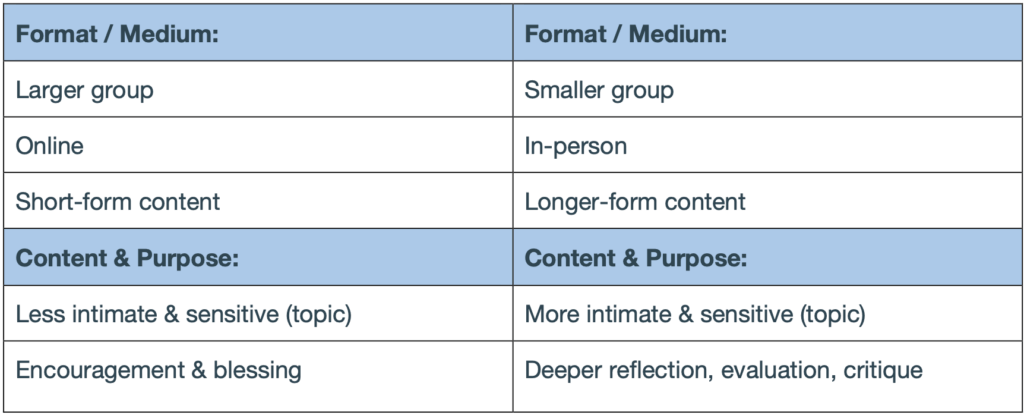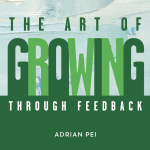One of the reasons I wrote and released The Art of Growing Through Feedback is that it seems harder and harder these days for people to talk to one another. Instead of delivering feedback with grace and truth, people are prone to critique, belittle, and label others. Instead of receiving feedback humbly and graciously, we can be prone to isolate or huddle in communities where nobody will challenge us for our own good. In this increasingly polarized world, how do we begin to have conversations?
I’d like to start by suggesting a framework for where and when to engage in conversation, shown visually in the table below:

When we’re in larger groups of people, online, or in a medium of short-form content (social media posts and comments, group e-mails or texts, etc.): first, this is a good format for less intimate and sensitive topics. There’s a reason why we’re warned to not talk about politics and religion at a party—only now, the “party” often looks like hundreds of people online, and people can’t seem to stop doing it. Second, these more impersonal formats are best used for encouragement and blessing. If we’re going to post that comment or message, find something that will brighten that person’s day.
When we’re in smaller groups, are in person, or we’re engaging with longer-form content (books, articles, etc.): this is a better format for more intimate and sensitive topics. When there are fewer people and we’re face to face, it’s easier to have an emotional connection—which is so important if we’re sharing something personal. This is also a more appropriate format for deeper reflection, evaluation, or critique—because longer-form content allows for more nuance and exploration of a topic.
Of course, these are just some ideas of guidelines based on what I’ve seen work, and what I’ve seen backfire. This may sound obvious—and of course this is easier said than done—but many of us were never really given much guidance or guidelines on how to engage the Internet and its increasingly rapid, impersonal, and connected world. In fact, we sometimes got the opposite kind of guidance, as technology and “efficiency” pushed us to simplify and combine our various modes and groups of communication (i.e. “isn’t it just so much simpler to write one sentence on social media and update all our contacts about our lives, in one fell swoop?”).
Not only does this remove the personal and intentional aspects of communication, but it also can add confusion. I’ve heard and seen too many people who share a personal update on social media, only to be discouraged by a few who critique them because the topic touched on a polarizing issue for them. Again, this is unfortunate but might not be a surprise, given how communication tends to work.
Sometimes we need to get support, or to vent about something. Other times, we may want or need to educate or share insights with others. However, these contexts and purposes are different, and often require different kinds of audiences, engagement, and expectations for response. We don’t have to simplify and mix these contexts into one big group. Instead, we can start thinking more intentionally before we communicate using the kinds of guidelines in the chart above. This may not only help us reduce some unnecessary stress and anguish, but provide some direction in how, when, and where to have successful conversations in a polarized world.
 I write about this kind of discernment in communication—including if and when to deliver feedback—in my book The Art of Growing Through Feedback (now available in paperback and e-book). I’m offering bulk discounts up to 45% off + a free Q & A session with me! Please write me if you’re interested in using it for your team, company, book club, classroom, church, or other group.
I write about this kind of discernment in communication—including if and when to deliver feedback—in my book The Art of Growing Through Feedback (now available in paperback and e-book). I’m offering bulk discounts up to 45% off + a free Q & A session with me! Please write me if you’re interested in using it for your team, company, book club, classroom, church, or other group.
Discussion or Reflection Questions:
- What have been your experiences with communication in larger groups, online, and short-form content (social media posts and comments, group e-mails and texts, etc.)? What are some of the mistakes you’ve seen made, and lessons you’ve learned about what works in those formats, and what doesn’t?
- How about communication in smaller groups, in-person, and longer-form content (books, articles)? What differences do you see, and what lessons have you learned about what works in those formats, and what might not?
- Where specifically can you be intentional this week in choosing communication contexts and formats wisely? What ideas or applications of these guidelines might aid your effectiveness, and save you some grief?
Thank you for reading this article! My name is Adrian Pei, and I’m the CEO of The Change Navigation Company, where we provide customized leadership training for organizations and leaders. You can download a free pdf of this article by clicking on the icon below, which also contains a discount offer for our services. I hope we get a chance to connect soon!

